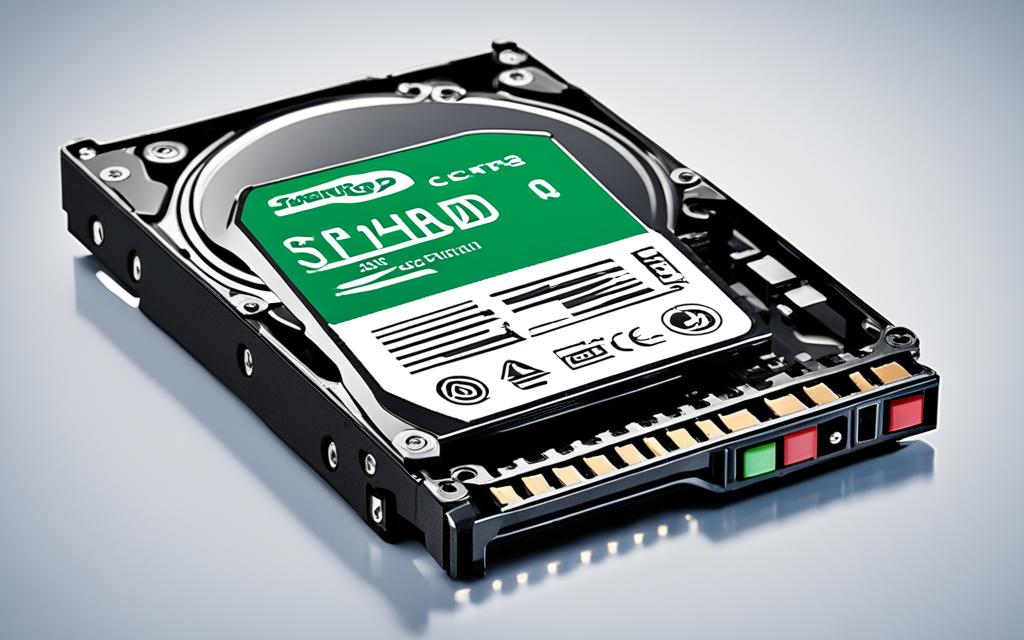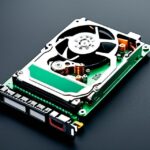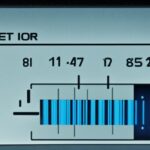Table of Contents
The world of data storage is huge and always changing. Yet, the SATA HDD (Serial Advanced Technology Attachment Hard Disk Drive) stands strong as a main part of computing power. Since 2003, SATA HDDs have been key for many desktop and laptop computers. They offer a fast interface rate of 6 Gb/s and can move data up to 600 MB/s. This has made them a benchmark in hard drive technology1. Their sizes range from 500 GB to a whopping 16 TB. This makes them a favourite for big businesses looking for cost-effective storage solutions1.
SATA technology has not just boosted storage capacity and access. It’s also helped link old-style spinning disks with new tech like SSDs. Although SSDs are faster, SATA HDDs remain a reliable, budget-friendly choice for many uses. Today’s world runs on data, and SATA HDDs still have a significant role. As we explore more about how SATA HDDs work and how they perform, we’ll see why they still matter amid newer technologies. They help shape your approach to storing data.
Key Takeaways
- SATA HDDs have been essential in data storage since they first appeared.
- With sizes ranging from 500 GB to 16 TB, they serve both personal and professional storage needs.
- Expect a SATA HDD to last about 3 to 4 years, which is worth considering when planning storage2.
- For over two decades, SATA technology has stayed at the forefront of the market.
- As SATA interfaces evolve, they keep getting better in performance.
Introduction to SATA Technology
SATA stands for Serial ATA. It’s a key data transfer interface connecting storage devices like hard drives and SSDs to a computer’s motherboard. The creation of what is SATA happened in the early 2000s. It was through the joint effort of big companies including Intel and IBM. This new tech replaced the old PATA and offered speeds up to 150 MB/s initially. SATA III, the newest version, can go as fast as 600 MB/s.Discover more about SATA technology here.
What is SATA?
SATA can work in different modes such as AHCI and RAID, adding to its versatility. It mainly uses a 6-pin data connector and a 15-pin power connector. You’ll find SATA drives in various sizes, fitting many devices. For HDDs, sizes are typically 2.5 or 3.5 inches. SSDs are usually at 2.5 inches.
Evolution of SATA Interfaces
The development of SATA technology brought significant improvements over time. It began with SATA Revision 1.0, supporting 1.5 Gbit/s. Through the years, it advanced to SATA Revision 3.2. This update shot the maximum transfer rate up to 16 Gbit/s, a boon especially for solid-state drives. It included the new SATA M.2 interface. These steps show SATA’s growth to meet the needs of today’s tech.
What is a SATA HDD?
A SATA HDD stands for Serial Advanced Technology Attachment Hard Disk Drive. It is crucial for storing lots of data on computers. These hard drives offer good speed for moving data, lots of space for files, and work well with different operating systems. You’ll find SATA drives in two sizes: 3.5 inches for desktops, and 2.5 inches for laptops.
Defining the SATA HDD
SATA HDDs are a step up from older storage technologies. They work faster, reaching speeds up to 600 megabytes per second. This beats the old PATA tech3. They use less power too, making them great for gadgets you carry around. SATA changed how storage devices connect, making it easier for modern computers to use multiple devices at once4.
Technical Specifications and Features
SATA HDDs are important for computers we use daily. They can hold a lot of data, from 2 to 20 terabytes5. These drives make managing data easier with features like Native Command Queuing and hot-swapping. This lets you switch out drives without turning off your computer. Their failure rates are low, between 0.9% and 1.9%, showing they’re dependable5.
| Feature | Specification |
|---|---|
| Maximum Speed | 600 MB/s |
| Capacity Range | 2 to 20 TB |
| Form Factor | 2.5-inch and 3.5-inch |
| Annualised Failure Rate | 0.9% to 1.9% |
| Power Consumption | 5 to 10 W |
| Noise Level | 20 to 40 dB |
Understanding SATA Connectors and Cables
SATA connectors and cables are essential for the performance of SATA HDDs. Their design improves usability and compatibility. SATA HDDs have two main connectors: one for data and one for power.
SATA Data and Power Connectors
The SATA data cable has a 7-pin connector for efficient data transfer. The SATA power cable has 15 pins, providing +3.3V DC, +5V DC, and +12V DC. Devices linked to SATA ports work smoothly together. They offer bands of data rates. For example, SATA-I does 150 MB/sec, SATA-II does 300 MB/sec, and SATA-III goes up to 600 MB/sec6. This makes them much better than the older PATA interfaces, which had limits in speed and design.
Advantages of SATA Cable Design
SATA cables have a sleek and strong design. This design allows for better airflow and less clutter inside computer towers. SATA data cables can be as long as a meter for inside connections. This makes setting up systems in different places easier7.
They’re designed to have features like angled connectors to simplify installation. Cable flexibility helps manage setups in packed spaces. This improves user experience and lessens issues with cables coming loose8.
| Connector Type | Pin Count | Voltage Supply |
|---|---|---|
| SATA Data Cable | 7 pins | N/A |
| SATA Power Cable | 15 pins | +3.3V DC, +5V DC, +12V DC |
In conclusion, SATA technology boosts data speeds, reliability, and efficiency of hard drive connections. This technology pushes storage solutions forward significantly7.
Performance of SATA HDDs
The performance of SATA HDDs focuses on how fast they transfer data and their reliability. Knowing this helps users make better choices.
Data Transfer Rates
For SATA HDDs, data transfer speed is key. Initially, SATA drives transferred data at 150 MB/s. With SATA III, speeds have jumped to 600 MB/s. This makes these drives faster at accessing and getting large files, perfect for everyday computer use.
Reliability and Longevity of SATA HDDs
Reliability is crucial for SATA drives. New drives might fail more at first but get more reliable over 18 months. After this time, there are fewer problems, showing they last longer and are more stable. Catastrophic failures are rare. Users are more likely to see gradual data loss. It’s vital to regularly check these drives and back up data to protect important information. By doing so, SATA drives become a trustworthy storage optioncompared to other storage solutions9.
Comparative Analysis: SATA HDDs vs SSDs
When we look at storage options, we see a big difference between SATA HDDs and SSDs. Those who need to watch their spending find SATA HDDs a good choice. These drives are great when you need a lot of space without spending too much.
SATA HDDs stand out for their low cost and large storage space. This makes them a popular option over SSDs, which tend to be pricier.
Cost-Effectiveness of SATA HDDs
SATA drives are quite affordable, costing between £40 and £60 for a 1TB internal 2.5-inch model. On the other hand, SSDs of the same size are pricier, starting at around £80. This means you pay more for each gigabyte with an SSD.
Yet, large 3.5-inch hard drives can cost less than 3 pence per gigabyte. This draws many to SATA HDDs for big storage needs10. If speed isn’t a top priority, SATA HDDs are a smart, wallet-friendly choice.
Use Cases for SATA HDDs
SATA HDDs are versatile and used in many ways. For example:
- Personal Computing: They’re great as secondary drives for large media or backups, offering lots of space.
- Gaming: Gamers use them to archive games, where size matters more than speed.
- Data Centres: Businesses rely on them for storing big data sets securely for a long time.
SATA HDDs may be slower than SSDs but their lower cost and high storage make them appealing. They remain a popular choice for their price and capacity11.
Conclusion
SATA HDD technology plays a big part in today’s world of saving data. Even though SSDs are faster, SATA HDDs offer good deals, like being cheaper, holding more data, and working with many devices. They can transfer data up to 600 Mbps, which is great for moving lots of information quickly. This keeps them important in the market12.
HDDs are strong and can last a long time if we look after them well. They are a dependable way to keep our data safe13. Also, getting back lost data from SATA HDDs is usually easier than from SSDs. This gives users extra confidence, especially if things go wrong13.
The future looks bright for SATA technology. New updates and tech show that SATA HDDs will keep up as our need for computing grows. People should think about their storage needs and how SATA HDDs can help them with managing and backing up their data daily.
FAQ
What are the primary benefits of using SATA HDDs?
SATA HDDs are affordable and offer lots of storage space. They work well with many computers. These drives are dependable for keeping lots of data, making them great for people looking for value.
How does SATA technology improve data transmission?
SATA allows for faster data transfer by sending data one after the other. This method is faster than the old way where data was sent all at once. This means you get speedier data movements with SATA.
What is the lifespan of a typical SATA HDD?
A usual SATA HDD lasts about 3 to 4 years of use. Many drives even work better after 18 months. It’s crucial to regularly check and back up your data to keep it safe over time.
Are SATA HDDs suitable for gaming?
Yes, gamers like using SATA HDDs for extra storage or backup drives. They offer a lot of space without costing too much. This makes them perfect for keeping big game collections.
What are the key specifications to consider when choosing a SATA HDD?
Look at data transfer speeds, where SATA III can go up to 600 MB/s. Also, consider the drive size, usually 3.5 inches for PCs and 2.5 inches for laptops. Features like Native Command Queuing and the ability to swap drives while the computer is on add more benefits.
How do SATA HDDs compare with SSDs?
SATA HDDs are more affordable than SSDs if you need lots of storage. SSDs are faster, but SATA HDDs are still good for tasks that don’t need the quickest speed.
What types of devices commonly use SATA HDDs?
Many devices use SATA HDDs, like desktops, laptops, and servers. They’re especially common in data centers or for personal use where you need a lot of storage without spending much.
What role does SATA technology play in future storage solutions?
SATA technology is growing to meet future storage needs. It’s improving to hold more data and work more efficiently. SATA HDDs will stay useful as technology and our needs continue to change.
Source Links
- https://www.pluralsight.com/blog/it-ops/types-of-hard-drives-sata-ssd-nvme – SSD Guide
- https://www.gillware.com/hard-drive-data-recovery/what-is-a-sata-hard-drive/ – What is a SATA Hard Drive – Gillware Inc.
- https://recoverit.wondershare.com/hard-drive/what-is-sata.html – What Is SATA? How Does SATA Work?
- https://www.lenovo.com/us/en/glossary/sata/ – What is SATA? Explaining Data Storage Technology
- https://www.securedatarecovery.com/blog/types-of-hard-drives – Types Of Hard Drives – HDD & SSD (SATA, SAS, NVME)
- https://www.electronicshub.org/what-is-sata-cable-and-used-for/ – What Is SATA Cable And What Is It Used For?
- https://tripplite.eaton.com/products/sata-cables-and-speeds-compared – SATA Cables and Speeds Compared | Eaton
- https://www.digitaltrends.com/computing/what-is-sata/ – What Is SATA? Here’s Everything You Need to Know About It | Digital Trends
- https://www.avg.com/en/signal/ssd-hdd-which-is-best – SSD or HDD: Which Is Right for You?
- https://www.pcmag.com/news/ssd-vs-hdd-whats-the-difference – SSD vs. HDD: What’s the Difference?
- https://www.avast.com/c-ssd-vs-hdd – SSD vs. HDD: Which Do You Need?
- https://www.stellarinfo.com/article/everything-about-sata-hard-drive.php – Everything You Need to Know About SATA Hard Drive
- https://www.datarecovery.net/articles/what-is-sata-hard-drive.aspx – What is a SATA Hard Drive? Everything You Need to Know | ACE Data Recovery Services Article












